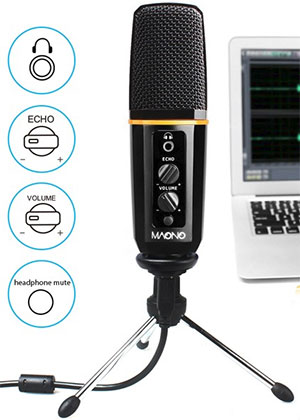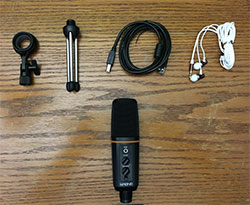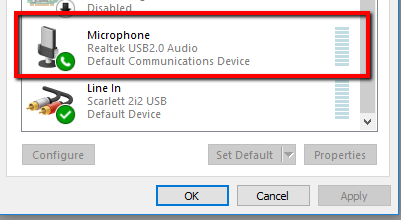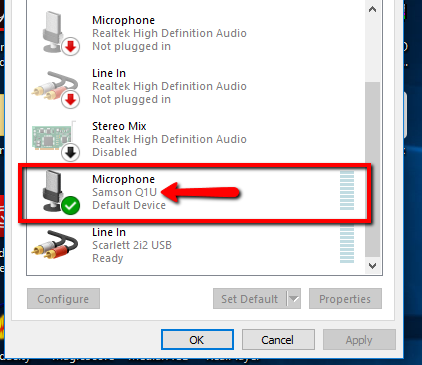Whether you are a pro or a newbie you need to understand that knowing that you need compression is way different from understanding that you do need one. Here is the good news for you aspiring sound engineers out there, it’s not as hard as most people think. You just need to know four things and you can achieve that recordings like professionals do.
Before all the hype the first thing you need to know is what a compressor does and how you can benefit from it. In a nutshell, a compressor is an automatic device to control your volume.
Read more here: https://www.recordingrevolution.com/why-the-pros-use-compression-and-how-simple-it-can-be/
Home Recording Equipment
Review Of The Maono AU-901 USB Microphone
 I just tested a USB mic called the Maono AU-901, which a USB microphone. The mic is intended primarily for podcasting, gaming, Skype, video voice-over, etc.
I just tested a USB mic called the Maono AU-901, which a USB microphone. The mic is intended primarily for podcasting, gaming, Skype, video voice-over, etc.
This mic costs $46.99 at Amazon.com.
As with all of my mic reviews, I recorded audio from the review mic and tested it against a comparable mic. In this case, I have audio from the Samson Q2U, which is in the same general price range – though a bit more expensive at $59. (See my review of the Samson Q2U here).
What Is This Mic?

It is a USB mic. So you don’t need a separate interface unit to connect it to your computer. The Maono is described in their manual as plug-and-play, “compatible with Win7, Win8, Win10 and Mac for voice recording.”
The Maono comes with the mic, a desk stand, a USB cable, a mic clip, and a set of headphones (earbud style) you can plug into the mic. See figure 1.
Most USB mics are plug-and-play these days. That means you don’t have to bother with loading a driver for it to work on your computer.

So the very first thing I noted was how well the plug-and-play worked.
Answer: very well. I plugged the USB cable into a USB port and it was instantly visible as an available mic in Windows Sound.
One thing that confused me, though, was how it was labeled in Windows Sound settings. I expected to see “Maono USB Audio,” or something similar. It took awhile for me to figure out that the entry reading “Realtek USB 2.0 Audio” was the Maono. See Figure 2. Realtek is the audio built into my computer’s motherboard. On my Mac, the Maono showed up as just “Microphone.”

Usually, a USB mic shows up with its brand name. For example, the Samson Q1U shows up as “Samson Q1U.” See figure 3. It’s confusing, though it’s a fairly minor quibble.
OK, So What Were The Pros?
As I said above, the plug-and-play worked instantly, which is good. That eliminates the hassle of dealing with drivers.
I also liked that the gain control was right there on the mic. That means you don’t have to rely solely on the Windows Sound settings to control the input. Just set it at “100%,” and you can use the “Volume” knob on the mic to control the input level.
This is a condenser mic, which usually means hyper sensitivity to p-pops. This mic yielded very few p-pops, which is good, and pretty rare. That also means less editing of plosives if you’re using the mic for recording (as opposed to using it for Skype, game chat, etc.).
And the sound quality was pretty decent on my voice.
One other interesting feature of the Maono was the “Echo” control knob on the mic. Even though the stated primary use is for podcasting and other spoken vocal applications, their site mentions the use of the built-in echo/reverb as something you can use for music recording. There is a sample of the echo on my voice in the audios below.
What Were Cons?
Noise. The self-noise (audible noise that is present BEFORE you even start speaking into it) was VERY loud. In fact it’s the loudest noise I’ve even heard from a USB mic. This is my number one complaint about this mic. You can hear what I mean in the samples below.
I made several recordings using a couple of different mics. Use headphones to listen to them if at all possible.
Just listen to the noise.
I recorded “silence,” by which I mean I simply hit the Record button and didn’t say anything. I did this with 3 different mics – the Maono AU-901, my old Samson Q1U (same price as the Maono) and the newer Samson Q2U. All of these mics are USB mics in the same general price range.
First is just the noise from the Samson Q1u (average noise volume = -52 dB):
Now listen to the noise from the Samson Q2U (average noise volume = -58 dB, 6 dB quieter):
Finally, here is the noise from the Maono AU-901 (average noise volume of -40 dB, 12 dB noisier than the Q1U, which I always considered to be pretty loud!):
To make absolutely sure that this was a fair comparison, I “normalized” the input levels of the 3 mics so that they were all equal by making sure that my vocal recording was the same average level (RMS) in all 3 mics. The Maono AU-901 was just very noisy.
It isn’t all bad news though. As I said above in the “pros” section, the audio quality of the Maono was pretty decent. Once I ran noise reduction on the vocal recording I made with it, the tones sounded pretty good. I compared them to the noise-reduced quality of a standard PC mic and the Maono was definitely better.
For comparisons of the audio quality between the Maono and the Samson, listen to a bit of text I read for a voice over sample:
Maono AU-901
Samson Q2U
What About The Echo On The Maono?
I mentioned that the Maono had a unique Echo control. It’s a knob on the mic that you can use to add an echo effect to your recording. this could be useful for music recording, or for effects on certain types of “hard sell” voice overs (think “Sunday, Sunday, SUNDAYYYY!!!”). Take a listen below:
Final Assessment
The Maono AU-901 would be a much better mic if it weren’t for the excessive level of background noise inherent in the mic itself. It’s much louder than other USB mics in the same price range. But since it’s pretty easy to filter out noise like that using standard noise reduction tools present in even the cheapest (even free) audio software, it isn’t as much of a problem as it might be. And the left over sound is not half-bad. Unfortunately, the more noise you have to remove from a recording, the more likely it is that the leftover audio will have some artifacts – usually called “the swirlies” is pretty high. And if you listen to the Maono sample with noise reduced above, you’ll hear some of these artifacts.
As I said in the Pros section above, there are things to like about The Maono AU-901. And it would be a no-brainer for the price IF ONLY it weren’t for the excessively loud noise. As it is, you’ll still sound better with this mic than you will with a standard computer mic – the type with the 1/8th inch pin that you plug into your sound card or the “mic” jack in a laptop.
Click here to find out more or to buy one for $46.99.
Choosing An Interface? Consider These Things Before You Do
Let’s face it, with the emergence of technology analog based studios are almost no longer to be found. Even the digital world has evolved in the past years from air based sound waves to virtual, ones and zeroes all based on the digital world. Upgrading your sound might not be that hard at all. That goes for your interface as well. So here are some things you need to consider if you are going for that upgrade.
Ask yourself what do you really need? Once you know what your needs are all the rest follows. So start contemplating and making your list
Read more here: https://www.sweetwater.com/insync/choosing-audio-interface/
Five Types Of Reverb
Although different in many areas, sound engineers and music producers still portray similarities like the love for coffee and learning about reverbs. For those who are new to this kind of scenario looking at a reverb algorithm can be quite intimidating. But we can fix this confusion by understanding what a reverb is and what are the different types of it.
A reverb processor is a device that uses an algorithm to turn a source sound into a similar version. This can be configured in a number of ways depending on its designers.
The types of reverbs are Rooms, Halls, Chambers, Plates, and Ambiences.
Read more here: https://theproaudiofiles.com/5-different-reverb-types-explained/
DIY Acoustic Panels
Looking to upgrade your home studio? Probably the most cost-effective way is by adding acoustic panels. You’re not just talking about aesthetics and design but improving your listening space as well. It’s actually easy and very affordable. With all the readily available materials in the market today you can choose one that fits your needs and your budget. Normally a compressed fiberglass is used in creating these panels. But if you want to go cheap but still very effective you can choose from a variety of household materials you can use as insulators. Now you may want to watch the video below if you are attempting to do so.
Watch video here: http://bobbyowsinskiblog.com/2017/09/07/cheapest-acoustic-panels/